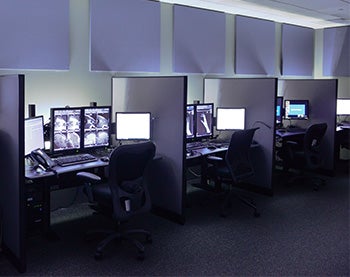New planning guide can improve radiology reading room design, ergonomics
 |
| Photo courtesy of RedRick Technologies Inc. RedRick provided lighting and sound design guidance as well as the sit/stand workstations at the musculoskeletal reading room at the Hospital of the University of Pennsylvania in Philadelphia. |
Being a radiologist can be a real pain and the latest technology is contributing to the problem, too — at least that's what research from various sources suggests. The good news is that help is available.
With 60 percent of radiologists sitting up to eight hours a day at a workstation interpreting large amounts of data for hours, using monitors in poorly lit rooms and with no ergonomic control over their physical environment, a large percentage report an array of physical problems.
A 2014 study conducted by the MarkTech Group says 66 percent of radiologists reported significant eye fatigue and 87 percent reported experiencing unspecified physical discomfort. That's just for starters.
A 2014 study published in The Journal of the American College of Radiology says that 60 percent of radiologists suffer from repetitive strain injuries (RSIs) as a result of poor ergonomics at work. The areas most affected are neck, shoulders, back, and wrists and hands.
The implementation of picture archiving and communication systems (PACs) may serve as an economical and convenient way to access images from multiple sources, but they have led to more aches and pains for radiologists, research says.
The good news is that those who underwent ergonomic training or used ergonomic equipment reported a significant decrease in pain.
That's where RedRick Technologies Inc., Mount Brydges, Ontario, Canada, comes in. RedRick provides ergonomic radiology furniture, monitor-mounting solutions and reading-room design guidance.
The company recently released the first planning guide focused on medical imaging reading-environment optimization in collaboration with CannonDesign, Chicago.
The planning guide provides practical, educational guidance for architects, designers, facilities planners and clinical departmental leaders involved in the design and renovation of medical imaging reading-room environments, by summarizing the best practices that meet the unique needs of medical imaging departments.
The guide defines the factors that constitute good reading-room design and siting, including how they enhance the practice of radiology. It emphasizes how to employ good ergonomic principles to eliminate the repetitive-motion injuries that often affect physician health.
The guide also helps to determine the proper reading room location to enhance communication between radiologists and the clinicians they serve.
Eliot Siegel, M.D., professor and vice chair at the University of Maryland School of Medicine, department of diagnostic radiology, has been investigating reading-room design since implementing the first filmless radiology department in 1996. He believes that reading-room optimization is a long overlooked opportunity to reinvent radiology.
"Since the inception of PACS almost 20 years ago, the medical imaging community has learned a lot about how good reading-room design can improve quality of care and customer service, both of which enhance the value of radiology," Siegel says. "The planning guide is a valuable tool for ensuring [that] more organizations benefit from this collective knowledge."
Carlos Amato, AIA, ACHA, LEED AP, EDAC, principal/health care architect at CannonDesign and planning guide co-author, points out the importance of reading-room design and location.
"Good environmental and space design ensures that a reading room supports the operational, clinical and educational needs of the department by minimizing distractions and providing a comfortable working environment," he says.
The planning guide breaks the overall reading environment into primary, secondary and tertiary zones to enable the designer to gain a more holistic understanding of the impact of room lighting, sound and climate control, room flow, layout, siting, access and ergonomics.
It also includes a checklist to facilitate implement of the guidance, and points out factors that may impact the future of medical imaging and reading-room design.




